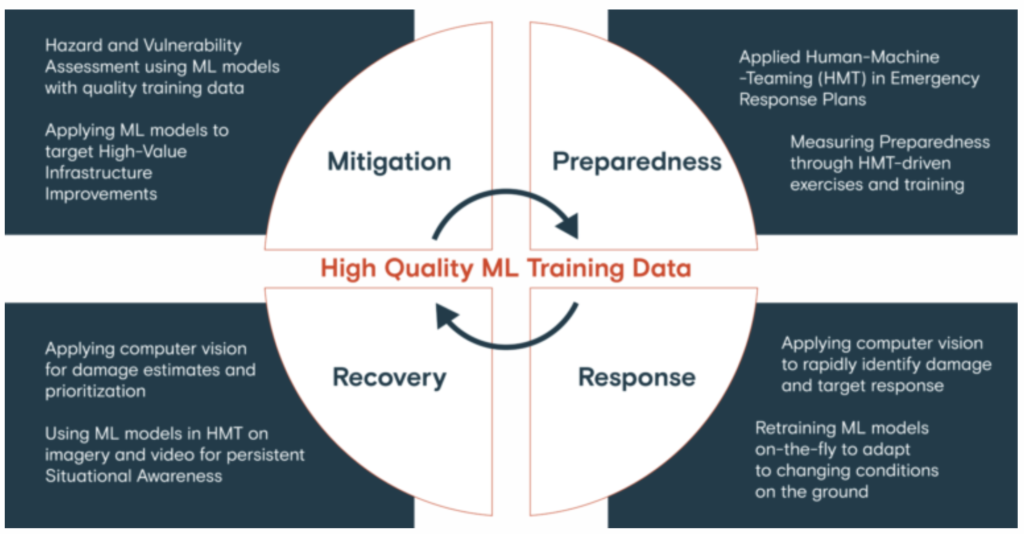Driving Transformational AI Innovations in Disaster Response and Recovery


Natural disasters such as floods, hurricanes, and wildfires are complex threats. Emergency Management resources are stretched thin from the increased frequency and intensity of damage. The estimated costs from these types of disasters in 2020 were “more than double the 41-year average of $45.7 billion”, at $95 BILLION. Since 1980, both the number of disasters and the overall spending have trended upwards. First responders require new tools to analyze and respond efficiently to disasters.
Traditionally, analysts manually combed through hours of video and images to identify damage and debris. First responders in the field would work around-the-clock to estimate damages and determine the funds needed for an affected community. This takes several hours or even days to complete depending on the size and scope of the damage.
How Machine Learning Supports Humanitarian Assistance and Disaster Relief (HADR) Efforts
By integrating Machine Learning (ML), analysts and first responders gather more information about damaged areas with greater efficiency and accuracy. These near real-time updates and predictions allow for faster response coordination and recovery efforts and helps keep the public apprised of the situation to respond appropriately. Quickly generated, accurate information is critical when pinpointing downed power lines, a home lifted off its foundation, or predicting the potential paths of a wildfire.
Figure Eight Federal provides a turnkey solution to build ML training data at massive scale. Not only do we have a ML platform developed by and for data scientists, but we also have a crowd of over a million annotators with authority to operate in a variety of scenarios. By teaming humans with machines (or Human-in-the-Loop), we transform hundreds of hours of video, and tens of thousands of images into high quality, usable ML training data. We also integrate directly into several platforms already in use by the government, such as the ArcGIS Portal. Analysts and first responders can select data, such as damaged homes or structures, on-the-fly to be speedily converted into training data.
Before machine learning models can operate effectively, the model must “learn” by being shown many examples of verified, ground-truth data instances (e.g. audio, text, image, or video data). The quality of training data sets critically affects the operation of an algorithm. Developing high-quality training data sets through data annotation (labeling), can be painstaking, laborious, technically challenging, and must be performed under rigorous quality control and security. It is, nonetheless, the most critical component. Nothing moves efficiently or effectively without high-quality training data.

By integrating Figure Eight Federal into core mission systems, emergency management partners can now rely on high-quality training data for any disaster.
From Preparedness to Working at the Response Edge: Making Human-Machine Teaming a Reality in the Emergency Management Lifecycle Through Quality ML Data Annotation

Comprehensive situational and operational awareness in disaster response requires access to data and the ability to transform it into actionable insight. Figure Eight Federal powers tools to enable awareness with machine speed and accuracy across the entire emergency management lifecycle.
Preparedness and Training
Figure Eight Federal’s ML training data helps emergency management build human-machine teaming capacity. First responders work diligently to prepare for a wide variety of disasters, collecting a wealth of data in the process. By leveraging quality, annotated and operational data (about specific geography, for example), Emergency Management is prepared to address new challenges at machine speed. In training or in practice, quality ML data can provide the ground-truth in exercises where human-machine teaming can save seconds, and lives.
Mitigation
By providing training data for ML models that can scan thousands of acres in minutes, Figure Eight Federal can enable first responders to target and mitigate risk. First responders can use ML models to prioritize areas where flood, fire, or hurricane damage is most likely to happen, and proactively contact risky areas to make necessary changes before a disaster occurs. Quality training data is crucial, though, to identify and prioritize among areas of greatest risk.
Response
“You had to have been there.” A point of failure for many ML models can be their “brittleness,” or their ability to not perform well in situations for which they were not trained. Through innovative approaches to building ML training data, however, Figure Eight Federal offers new opportunities to generate content with near real-time context. Figure Eight Federal can apply, for example, ML-assisted annotation to streaming data, or near real-time data, using ML to generate annotations that are peer-reviewed by annotators, reducing the time needed to train ML models while increasing their accuracy. In addition, Figure Eight Federal provides the ability to capture and label data for annotation at the edge on mobile devices. The ability to capture and annotate data at the edge and train ML models to perform better brings effective human-machine teaming to the problem.
Recovery
Disasters are not static, nor is the damage that is left behind. As waters recede, winds die down, and fires are slowly contained, there is a transition from tactical to strategic response and long-term sustainment of operations. ML models powered by quality training data can support both persistent situational awareness and logistics. Prioritizing among known and emerging threats is a constant need in a disaster zone. ML computer vision models can monitor and track problems as they evolve. ML models can also easily flag, and recalculate, logistical needs for affected areas dynamically. Robust ML models can help communities recover at the speed of relevance.

AI-powered Global Humanitarian and Disaster Relief
Figure Eight Federal combines annotated data with location analytics and AI for more efficient disaster response.
This comes together to, for example, rapidly distinguish objects and areas to locate flood-affected areas and infrastructure, working to identify areas that have been damaged or people that are at-risk or in-need. First responders, government decision-makers, and residents can then better deal with disaster relief and rescue operations.
Schedule a demo to discover how Figure Eight Federal will improve your HADR efforts.

